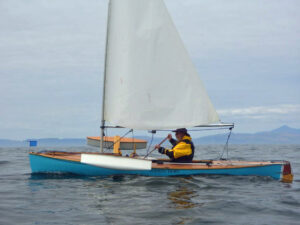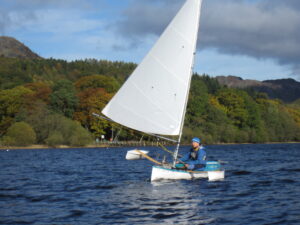For the canoeist who is used to controlling their canoe with a paddle, it is possible to get into canoe sailing without a rudder. Having a small to medium sized sail and a good, long, side-mounted leeboard is a good place to start. The leeboard needs to be positioned roughly at the centre of effort of the sail when viewed from the side. That will be around 1/3 of the way back along the boom behind the mast.
Positions of Rig, Leeboard and Seating
In the picture below, the leeboard thwart is mounted in the centre of the canoe on the carrying yoke. The mast is 2ft in front of the leeboard (using a 6ft boom) with a kneeling thwart 2ft behind the leeboard. The paddler is best sitting near the centre of the canoe so that it will sail flat with both ends in the water. They are at the widest part of the canoe so they can move to the side to help balance the force of the sail when sailing upwind, so the canoe will feel more stable. The sheet is attached to a bridle behind the sailor, runs along the boom and down to a cleat on the underneath of the carrying yoke. This allows the sailor to pull in the sail and lock it off so that both his hands are free for the paddle.
Sailing upwind
In the picture below, the sailor is running with the wind coming over their right shoulder. The leeboard is angled back and they are controlling their direction with a stern rudder. If the sailor puts the leeboard vertical and pulls in the sail in slowly, the canoe will slowly turn to the right and into the wind. He can keep pulling in the sail until it is near the centre of the canoe and the canoe will keep turning into the wind until they enter the “no-go zone.” (see ‘Sailing your canoe upwind’). At this point the sail will start to flap and the canoe will slow down. By leaning out to the right side and doing a few paddle strokes, the canoe will turn slowly turn to the left and the sail will power up again. You are now sailing upwind on a starboard tack (the wind is coming over the right side of the canoe).
You control your direction and follow the edge of the “no-go zone” by paddling harder or using sweep strokes on the right side, to drive you forward and turn you to the left, and by paddling slower or using J-strokes, allowing the sail to turn you to the right. Having the sail and leeboard set so that the canoe wants to turn into the wind (weatherhelm) is a safe way to control the canoe. If you get hit by a gust of wind the canoe will naturally turn into the wind and de-power.
Using forward paddle stokes to control your direction has a big advantage over just trying to steer like a rudder with your paddle. The paddle strokes and the power from the small to mid sized sail will combine to make you move upwind faster than either on their own. This allows a paddle sailor to buddy up with a canoe sailor with a much larger rig and to match their speed.

Going through the tack
As you sail upwind on your starboard tack you will eventually reach the left hand shore and run out of water. Before that happens you need to tack. If you stop paddling on the right side the canoe will slowly turn right up into the wind. Once the pressure is off the sail you can move your weight back into the centre of the canoe, and do a few sweep strokes on the left side. The canoe will continue to turn to the right until the boom comes over and the sail fills on the port tack.
You then need to move your weight onto the left side of the canoe to counter the sideways force on the sail and go back to controlling your direction with harder and softer paddle strokes, trying to follow the edge of the “no-go zone”, this time on a port tack.
Turning downwind
If you want to turn around and head off downwind you first need to move your leeboard and angle it backwards at say 45 degrees.This will alter the balance of the sail and the canoe will want to turn away from the wind. As it does so you need to uncleat the sheet and let the sail out .Once the boom is out about 90 degrees to the canoe you can cleat off the sail and then use your paddle as a stern rudder.
With the sail out to the right hand side of the canoe the wind force will want to turn the canoe to the left. Doing a stern rudder from the centre of the canoe is not ideal. Rudders on a canoe are hung on the stern to give you the maximum leverage to control the canoe. The sail can have quite a large turning effect in strong winds, especially with larger sails, and you might find it difficult to control your direction. Leaning back as far as possible will increase your leverage
i
There is another way to reduce this turning effect and make it easier to control your direction. If you use your body weight to bring the centre of effort of the sail over the centre of the canoe you will reduce the turning moment. To do this with the sail out to the right, move your body weight to the left and tip the canoe over to the left. When the centre of effort of the sail is directly over the centre of drag of the hull the turning effect will disappear. You can now control the direction of travel much more easily with your stern rudder. It is even possible to control your direction just by the heel of the canoe. Heel it back to the right a bit and the canoe will turn to the left. Heel it a bit more to the left and it will turn back to the right.

This effect is easier with a taller, narrower sail, like the 35 sq ft Bermudan. You don’t have to heel the canoe too much to bring the centre of effort over the middle of the canoe. With a lower wider rig (like a reefed lugsail) you might have to heel the canoe too far to get its centre of effort over the middle of the canoe to completely cancel the turning effect of the rig. however, it is still worth heeling the canoe a bit to reduce the turning effect and make steering with the paddle easier.
Practice and experiment
These are all useful skills to practice even with a canoe with a rudder. Rudders do sometimes get damaged and having a way of getting back home by paddle sailing can be a useful set of skills to get you home in an emergency.
Using a long leeboard and seeing how its position affects what you need to do with the paddle to keep you on track is something that you need to experiment with. Depending on how hard you want to paddle, angling the board forwards or backwards will alter the balance of the sail power and you can adjust it to suit yourself. Angling it forwards you will have to paddle harder to keep the canoe sailing well and out of the “no-go zone”. Angling it backwards a bit will make it more balanced and your paddle strokes will need to be more gentle, although you will end up moving slower.
Paddle Sailing a canoe with a larger rig in light conditions
It is useful to learn how to paddle sail, even if you have a rudder and a larger sail. It is a good skill to master for light weather sailing to help you move faster. In light airs if you are just sailing upwind or across the wind you might only be making 1 or 2 knots. By using your paddle to help increase the speed you can get more wind over the sail (apparent wind). This increased wind speed will power you along faster, and the combination of paddle and increased wind force on the sail will now move you at 3 or 4 knots. This form of motor sailing is unique to sailing canoes. By locking off the tiller to keep you on track you dont need to waste paddling energy in controlling your direction. As you go faster you will have to sheet in the sail a bit more to keep the sail pulling well (keep glancing at the tell tales to make sure the wind is well attached to the sail.) The paddling effort is much less than trying to paddle alone as the increased wind speed will mean that the sail is doing most of the work.
In light airs if you are just sailing upwind or across the wind you might only be making 1 or 2 knots. By using your paddle to help increase the speed you can get more wind over the sail (apparent wind). This increased wind speed will power you along faster, and the combination of paddle and increased wind force on the sail will now move you at 3 or 4 knots. This form of motor sailing is unique to sailing canoes. By locking off the tiller to keep you on track you dont need to waste paddling energy in controlling your direction. As you go faster you will have to sheet in the sail a bit more to keep the sail pulling well (keep glancing at the tell tales to make sure the wind is well attached to the sail.) The paddling effort is much less than trying to paddle alone as the increased wind speed will mean that the sail is doing most of the work.

Running Downwind
Running downwind with a larger rig it is again useful to lean the canoe to bring the centre of effort of the sail over the middle of the canoe. As a result the turning effect of the sail will be reduced so that the rudder will not have to work as hard to keep you on track. This reduces the drag from the rudder and will make you sail slightly faster. Again it will make it easier to control the direction of travel and make it possible to manage steering with a paddle.